Generative AI Statistics By Industry, Sector, Revenue and Facts
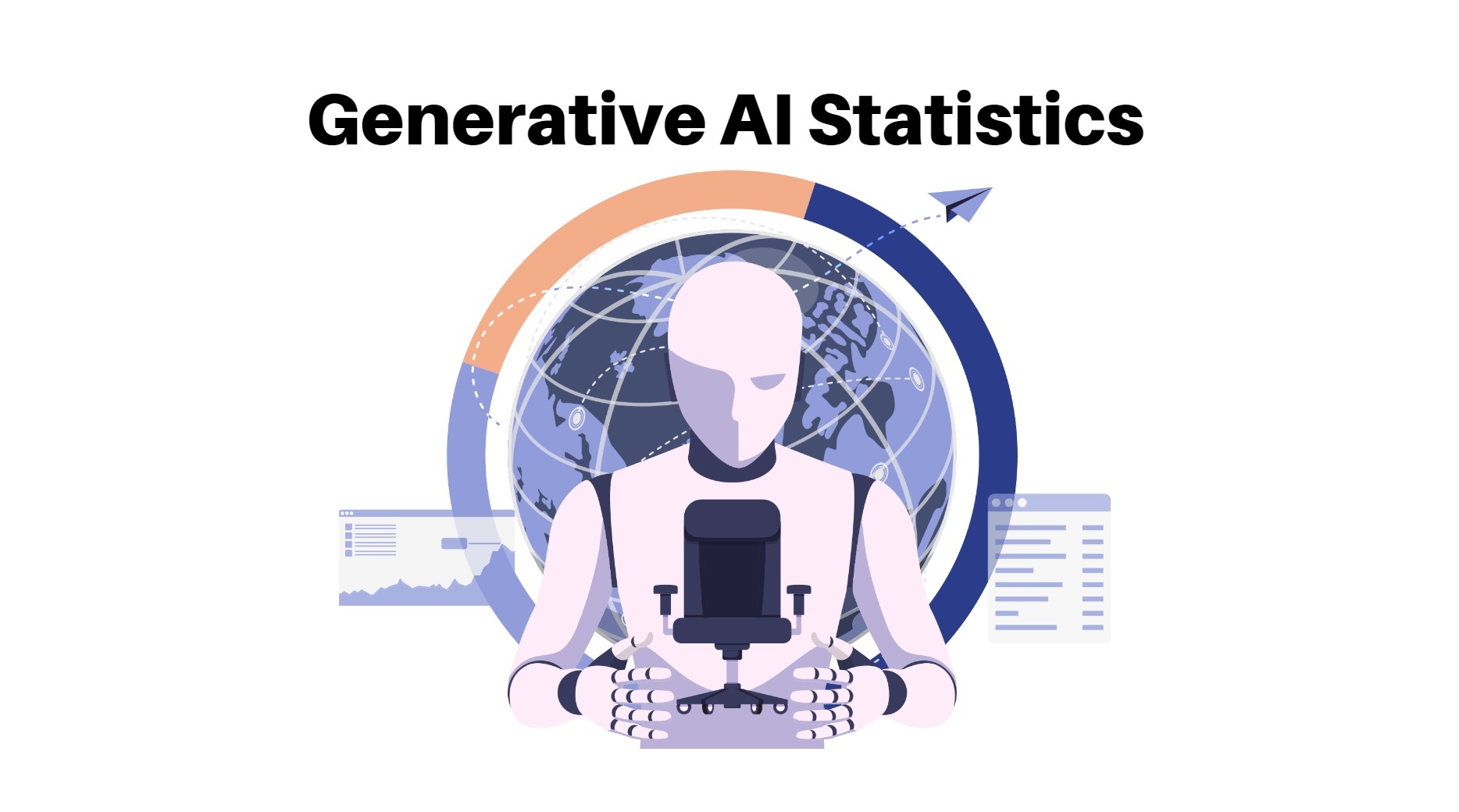
Page Contents
- Introduction
- Editor’s Choice
- What is Generative AI?
- Features of Generative AI
- Advantages of Generative AI
- Disadvantages of Generative AI
- Trends of Generative AI in 2023
- General Generative AI Statistics
- Generative AI predictions by Gartner
- Generative AI Statistics By The Adoption Rate
- By Industries
- By Generation
- Generative AI-based Startups By Sector As Of 2023
- Generative AI Statistics By Interest
- Conclusion
Introduction
What kind of a world we are today living in? It is surely similar to Doraemon’s technologically developed world, yet we focus on tools rather than actual gadgets. But believe us, in no time, there will be many inventions that can are going to change the life of a human being. With the recent release of ChatGPT-4, we are already stepping into advanced technology! But what else could be more said if the creators of ChatGPT itself are scared that it will destroy humankind.
These Generative AI Statistics are guided by various segments along with recent startups found in the world which have unlocked a new level of creativity.
Editor’s Choice
- As of 12th February 2023, the popularity score of generative AI reached 100 and it stagnant since then.
- The leading process as embedded by AI capability is the robotic automation process.
- As of 2023, less than 10% of residents in the United States of America have used generative AI for their social media accounts.
- Generative AI Statistics state that, by the year 2025, 10% of all data produced globally will be contributed from generative AI.
- By the year 2030, the generative AI market will reach $15.7 trillion with an expected increase in global GDP resulting in 26%.
- The projected annual growth rate by the year 2027 is 33.2%.
- As of 2022, the interest of investors in generative AI also increased as it received around $2,654 million in funding with a mere 110 deals.
- By the year 2032, the global Generative AI Market is projected to grow at a CAGR of 36.10% reaching $188.62 billion.
- As of 2022, North America contributed 42.10% of the global market share for the generative AI market.
- The major advancements of generative AI are developed by big brains of Meta, Nvidia, DeepMind, Google, Adobe, and OpenAI in collaboration with various top universities such as MIT, Stanford, and UC Berkeley.
What is Generative AI?
Generative AI or Artificial intelligence is a type of AI that is designed to create a new form of content as instructed. Generative AI works by analyzing large datasets. It can be used to create texts, audio, a new type of digital videos or code, etc… As a result, the adoption has paced in many industries such as robotics, banking, information technology, healthcare, and many others.
It is expected that in the coming years, the global market will reach to trillion dollars. This is just a starting phase of developed technology and yet unbelievable stuff is yet to happen. Some of the known examples of Generative AI are Google Bard, Dall-E, Bing, and ChatGPT.
Features of Generative AI
There’s nothing specific the generative AI cannot do. But if we look at some interesting features here are some;
- It can create photorealistic art in a desired style.
- It can write emails, draft any legal document, and answer your questions.
- Generative AI can help in suggesting drug compounds.
- It can optimize chip designs.
- It can write music of your choice or can create recipes with given ingredients.
- It can dub movies or any other content in various languages.
- Increases business productivity and accuracy.
- If you are bored, you can play games with generative AI.
- It can help you solve mathematical problems.
- And… the list is unending……
Advantages of Generative AI
- Automates manual process.
- Advances the response to general and specific technical queries.
- Simplify the complex information.
- Helps in content creation.
- Creates realistic representations.
- In terms of customer service, automates the responses.
Disadvantages of Generative AI
- It does not provide a reliable source of information.
- Can’t always provide correct answers.
- The knowledge is limited for such AI.
- Considering the realistic content make it difficult to identify human-created content.
- Provided results can create debates as they could show hatred and bias.
- End of thinking capability for humans.
Trends of Generative AI in 2023
- Influencers as well as content creators on social media are using generative AI tools to increase their fanbase.
- In the coming years, startups with AI-based processes will see an active number of funding.
- The major advancements of generative AI are developed by big brains of Meta, Nvidia, DeepMind, Google, Adobe, and OpenAI in collaboration with various top universities such as MIT, Stanford, and UC Berkeley.
- There is going to be more focus on multi-modal models to produce text and graphics.
- Even in the beta phase, ChatGPT is already posing a threat to Google.
- In the coming years, generative AI will support the creation of ultimate text-to-image modeling.
- In terms of customer service, audio generation will be supported to be eligible as natural language processing, big language models as well as voice synthesis.
- 3D generation is possible in terms of lifelike 3D models using voice commands and texts.
- Industry demand for generative AI is driven by the increased adoption of AI-based tools in business processes.
- Considering the Asia-Pacific market for generative AI is expected to grow at 36% by the year 2030.
General Generative AI Statistics
- Generative AI Statistics state that, by the year 2025, 10% of all data produced globally will be contributed from generative AI.
- By the year 2030, the generative AI market will reach $15.7 trillion with an expected increase in global GDP resulting in 26%.
- The projected annual growth rate by the year 2027 is 33.2%.
- As of 2023, there are more than 210 generative AI-based startups spread around the world.
- As of 2023, less than 10% of residents in the United States of America have used generative AI for their social media accounts.
- Moreover, Generative AI Statistics state that, the most appealing content for people in the United States of America, created by generative AI as of 2023 is content by artists and musicians on social media.
- The leading process as embedded by AI capability is the robotic automation process.
- As of 2022, the interest of investors in generative AI also increased as it received around $2,654 million in funding with a mere 110 deals.
- As of 2022, North America contributed 42.10% of the global market share for the generative AI market.
- Moreover, as per the Generative AI Statistics, as of 2022, the market was valued at $8.65 billion.
- By the year 2032, the global Generative AI Market is projected to grow at a CAGR of 36.10% reaching $188.62 billion.
- The fastest-growing generative AI Market is Asia pacific as of 2023.
- In the United States of America, as of 2021, generative AI received more than $52.9 billion of private funding.
- 66% of companies in customer service state that AI is making a positive impact on business performance.
Generative AI predictions by Gartner
- By the year 2025, 20% of the work of procedural code professionals will be replaced by generative AI.
- Moreover, by the year 2025, 30% of outbound marketing messages will be created synthetically in large organizations.
- 90% of material in quarterly reports and 20% of test data from consumer-facing use cases will be synthetically generated by the year 2025.
- As of 2024, European Union will pass legislation to make watermarking of AI-generated artifacts mandatorily.
- By the year 2025, 50% of drug development will be made by generative AI.
- Moreover, to increase product development efficiency,30% of manufacturers will use generative AI by the year 2027.

- The above chart explains the generative AI Use cases segmented by different industries as of 2023.
Generative AI Statistics By The Adoption Rate
By Industries
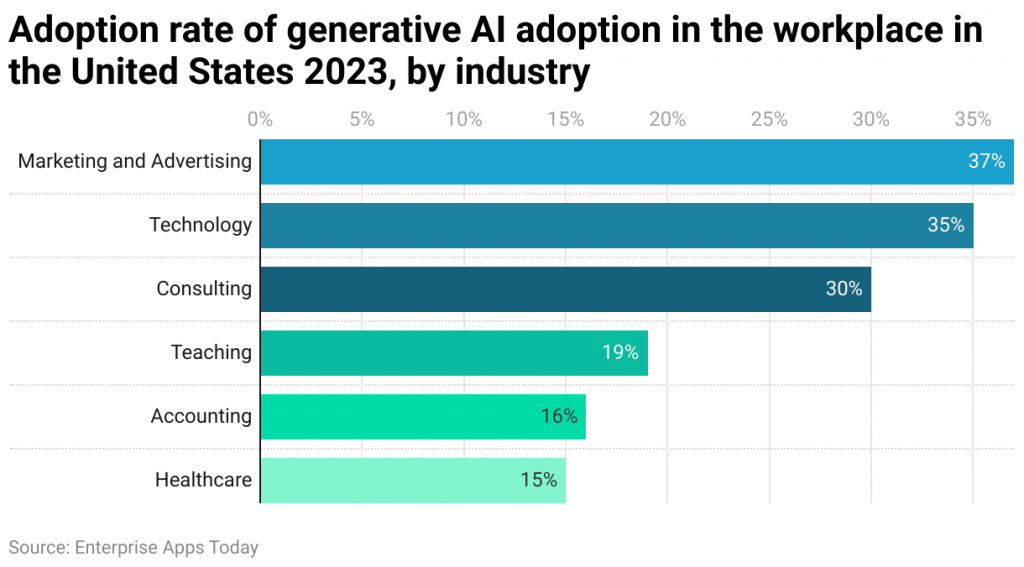
- Generative AI Statistics of 2023 segmented by industry-wise adoption rate state marketing and advertising as the highest resulting in 37%.
- Technology and Consulting industries are adopting generative AI at 35% and 30% of respective rates.
- Whereas, teaching and accounting industries are adopting at 19% and 16% whereas healthcare is the lowest of all resulting in a 15% of adoption rate as of 2023.
By Generation
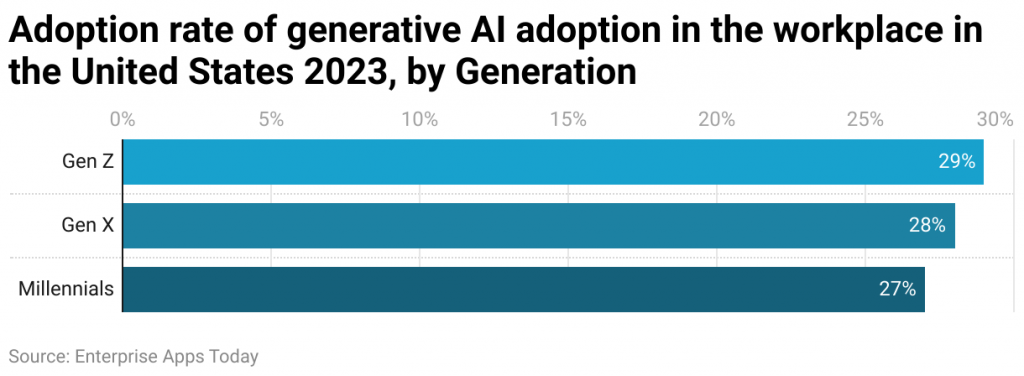
- As of 2023, in the United States of America, the highest generative AI adoption rate is in Gen Z resulting in 29%.
- On the other hand, with the mere difference, the adoption rate in Gen X is 28% while it is 27% in millennials.
Generative AI-based Startups By Sector As Of 2023
Category – Gaming (Characters/NPCs)
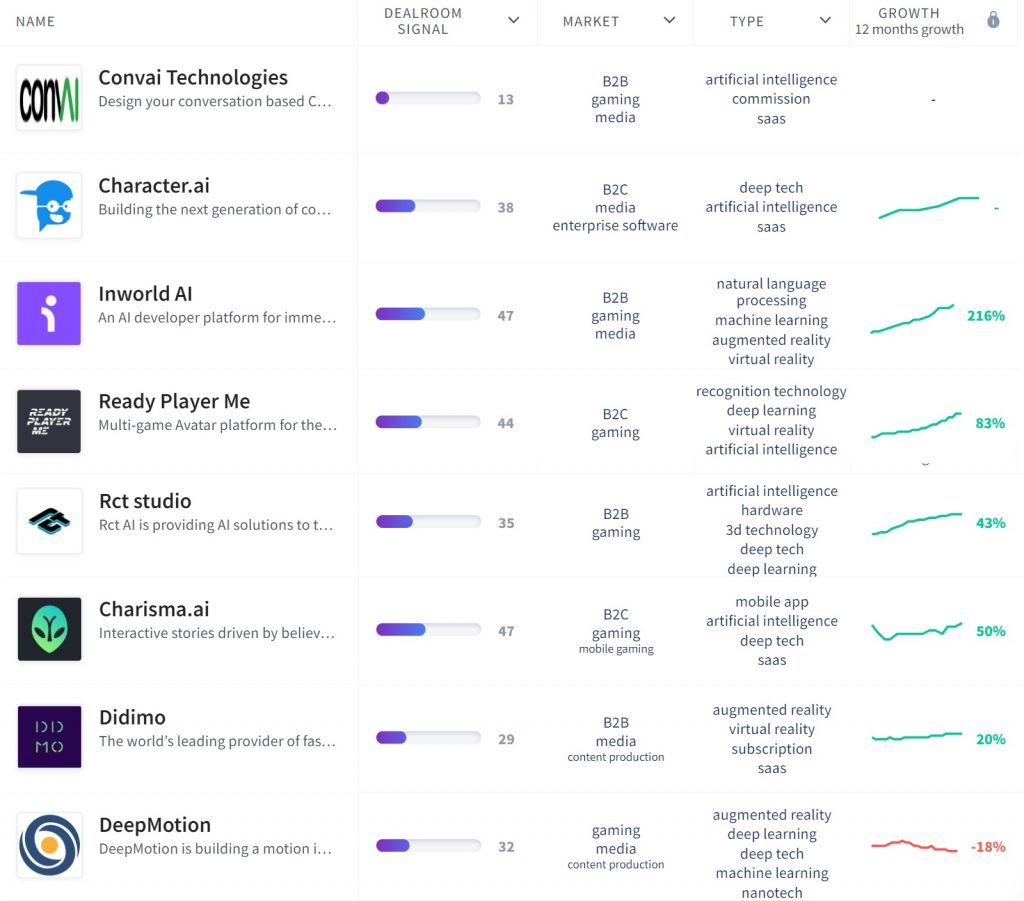
(Source: Dealroom.co)
1. Character.ai 2.Convai Technologies 3.Inworld AI 4. Ready Player Me 5. Charisma.ai 6. Pinscreen 7.Didimo 8. Rct Studio 9. DeepMotion.
Category – Gaming (3D World)
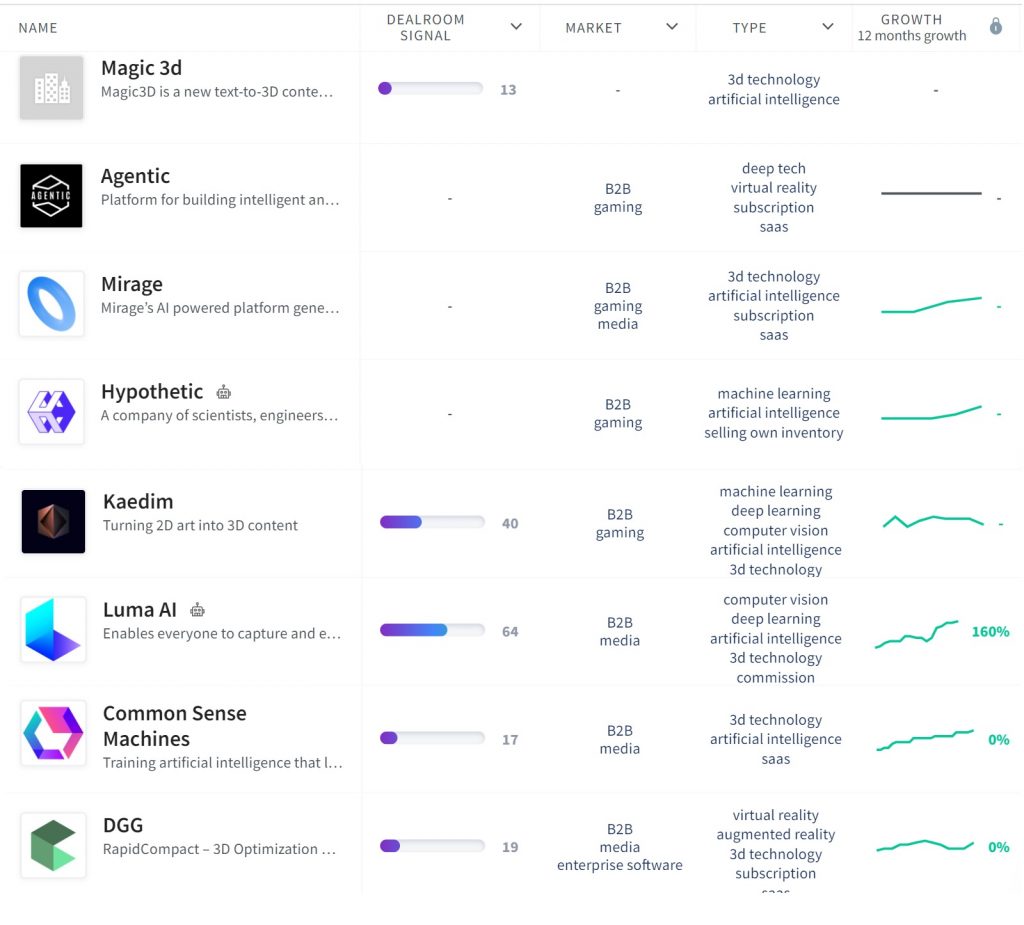
(Source: Dealroom.co)
1. Luma AI 2. DGG 3. Mirage 4. Kaedim 5. Hypothetic 6. Agentic 7. Magic 3d 8. Hexa 9. Promethean AI 10. Common Sense Machines and 11.In3D
Category – Text: Copy and Writing
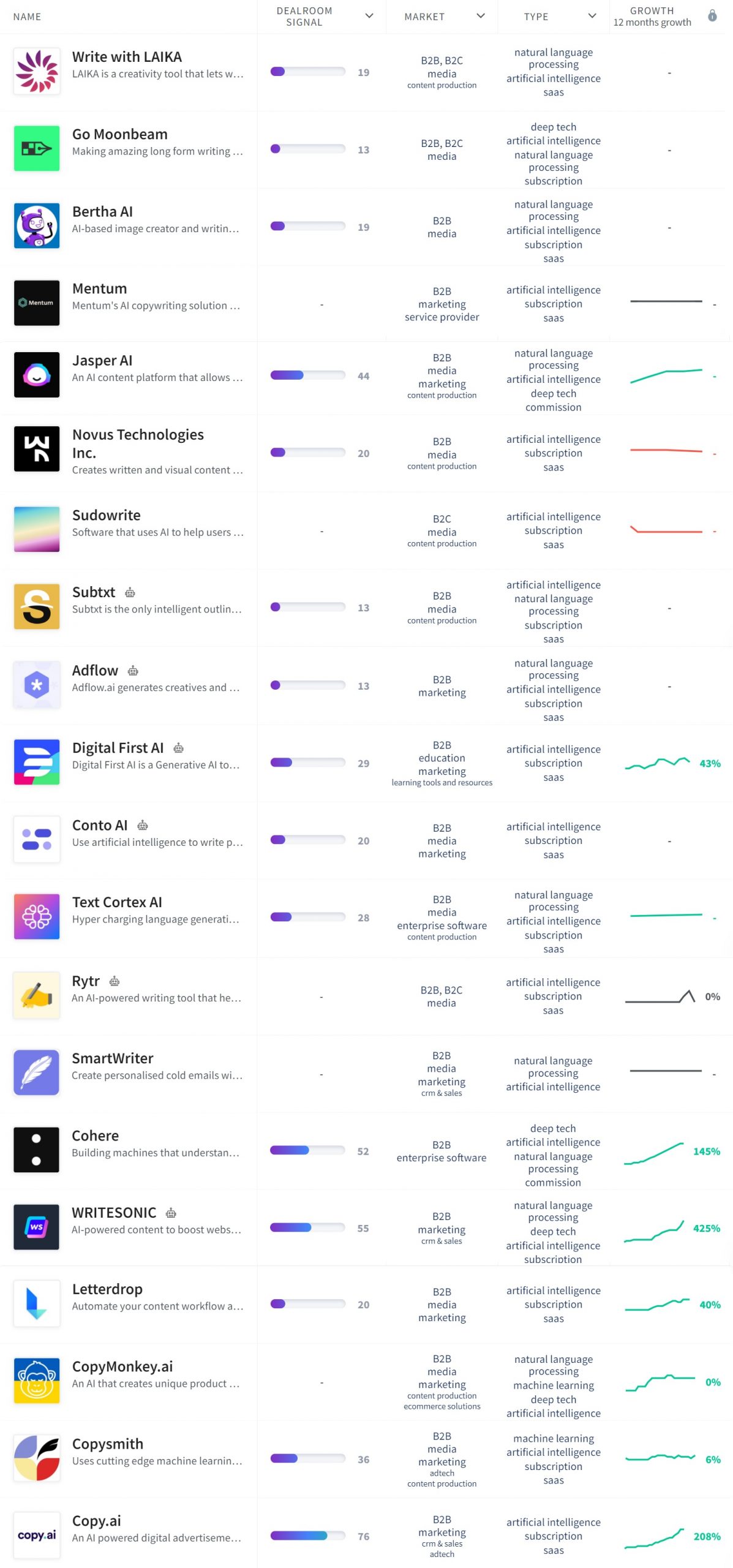
(Source: Dealroom.co)
1. SmartWriter, 2.WRITESONIC 3. Writer 4. Wordtune 5.CopyMoney.ai 6.Sudowrite 7. Omneky 8. Anyword 9. Copysmith 10. Jasper AI 11. HyperWriter 12. Regies 13. Compose 14. Copy.ai 15. Rytr 16.Text Cortex AI 17. Letterdrop 18.Hypotenuse 19. Bertha AI 20. Mentum 21. Pepper 22.Contents 23.Deepset 24. Cohere 25.AI21 26. Write with LAIK 27. Novus Technology 28. Digital First AI 29. YouMakr 30. Deepset 31. Go Moonbeam 32. Subtxt 33.Frase 34.Adflow and 35.Symbl.
Category – Text – Customer Relations and Other Assistants
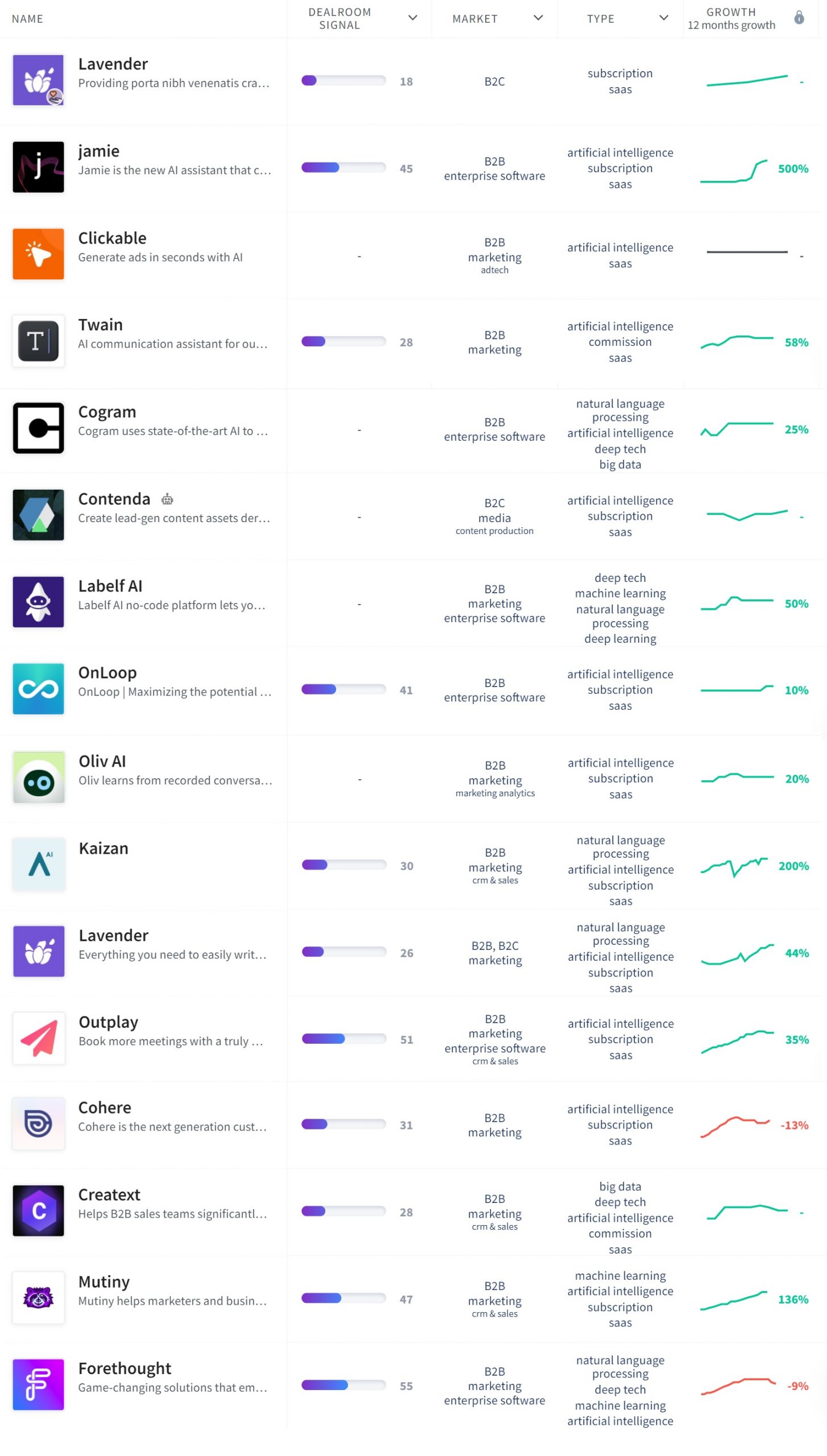
(Source: Dealroom.co)
1. Kaizan 2. Oliv AI 3.OnLoop 4. Creatext 5.Labelf AI 6. Lavender 7.Outplay 8. Contentda 9. Mutiny 10. Cohere 11.Twain 12.LabelfAI 13.Clickable 14.Jamie 15. Cogram and 16. Forethought.
Category – Personal AI Assistant

(Source: Dealroom.co)
Category – Legal
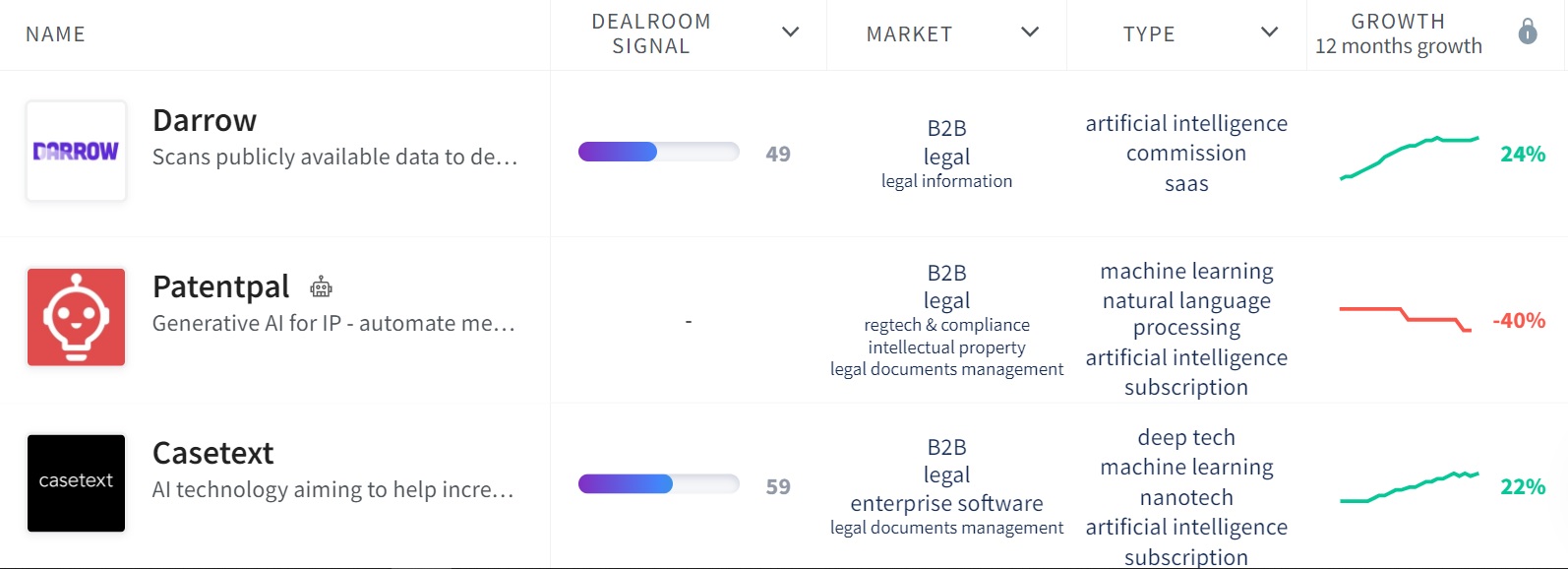
(Source: Dealroom.co)
1. Patentpal 2. Darrow and 3. Casetext.
Category – Text: Research and Knowledge
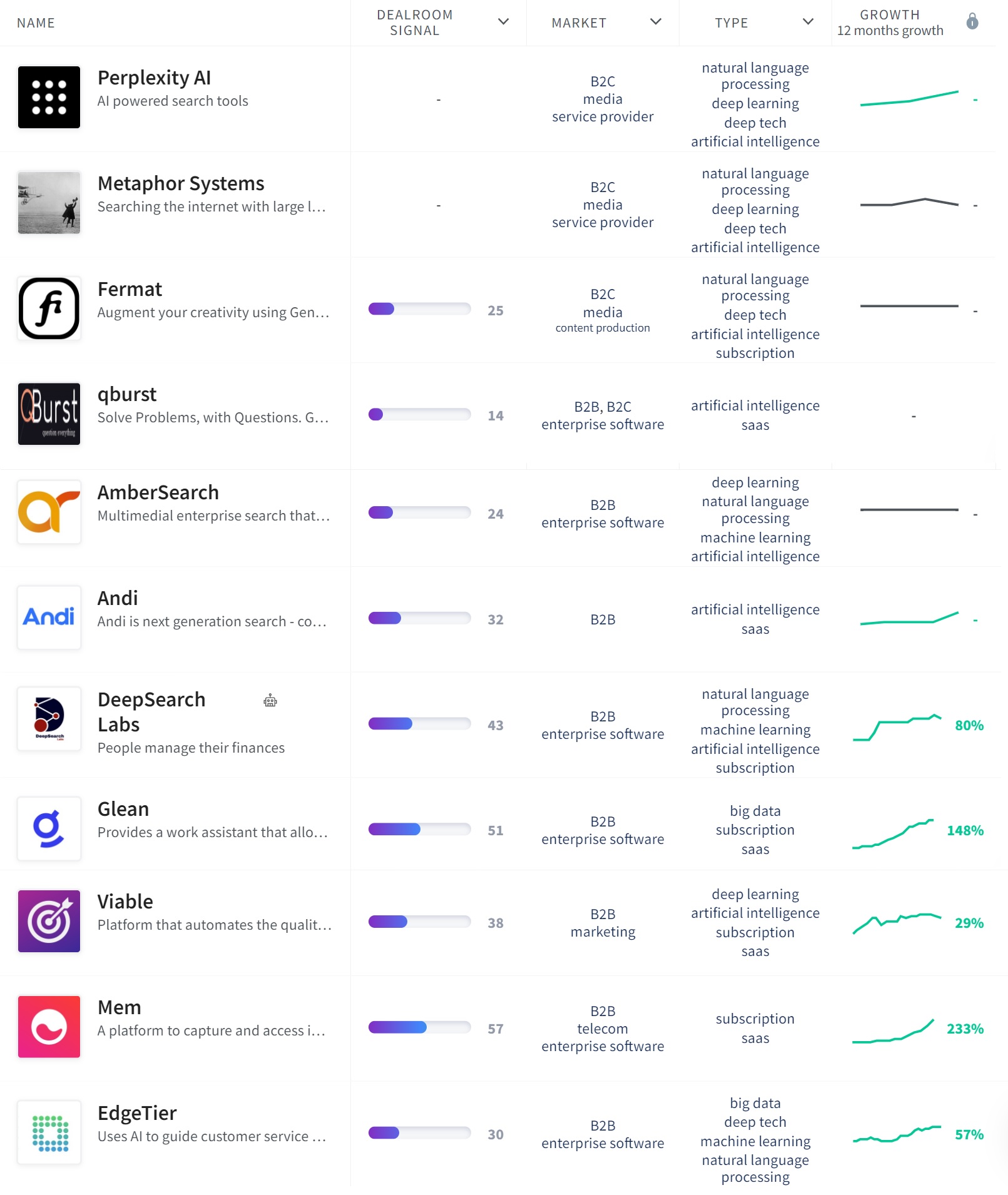
(Source: Dealroom.co)
1. Andi 2. Perplexity AI 3. Metaphor System 4.EdgeTier 5.qBurst 6.Viable 7.Mem 8.Ambersearch 9.Glean and 10. Fermat
Category – B2B Generative AI Integration
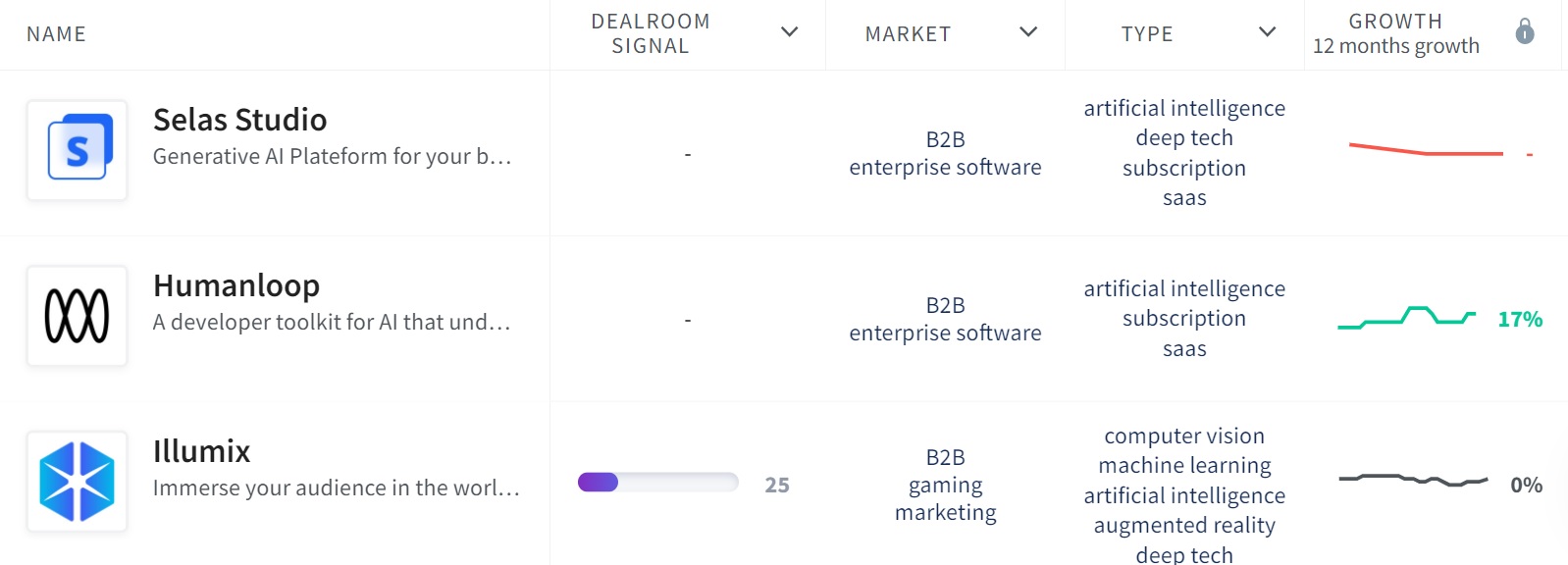
(Source: Dealroom.co)
1. Selas Studio 2. Illumix and 3. Humanloop
Category – Code Generation
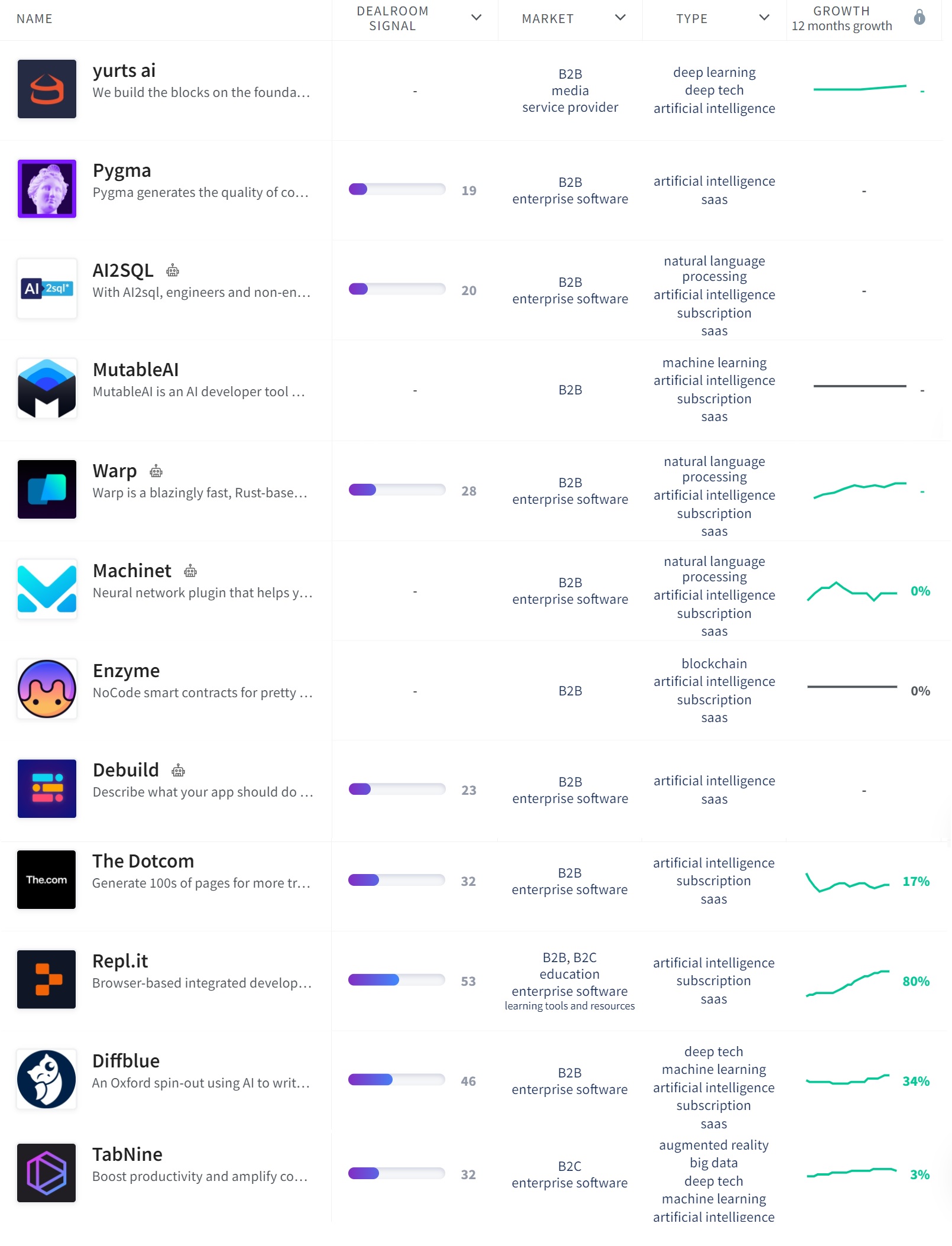
1. Enzyme 2.The Dotcom 3. Yurts AI 4. Debuild 5.MutableAI 6. Warp 7.Repl.it 8. Diffblue 9.TabNine and 10.Pygma.
Category – Dev Apps
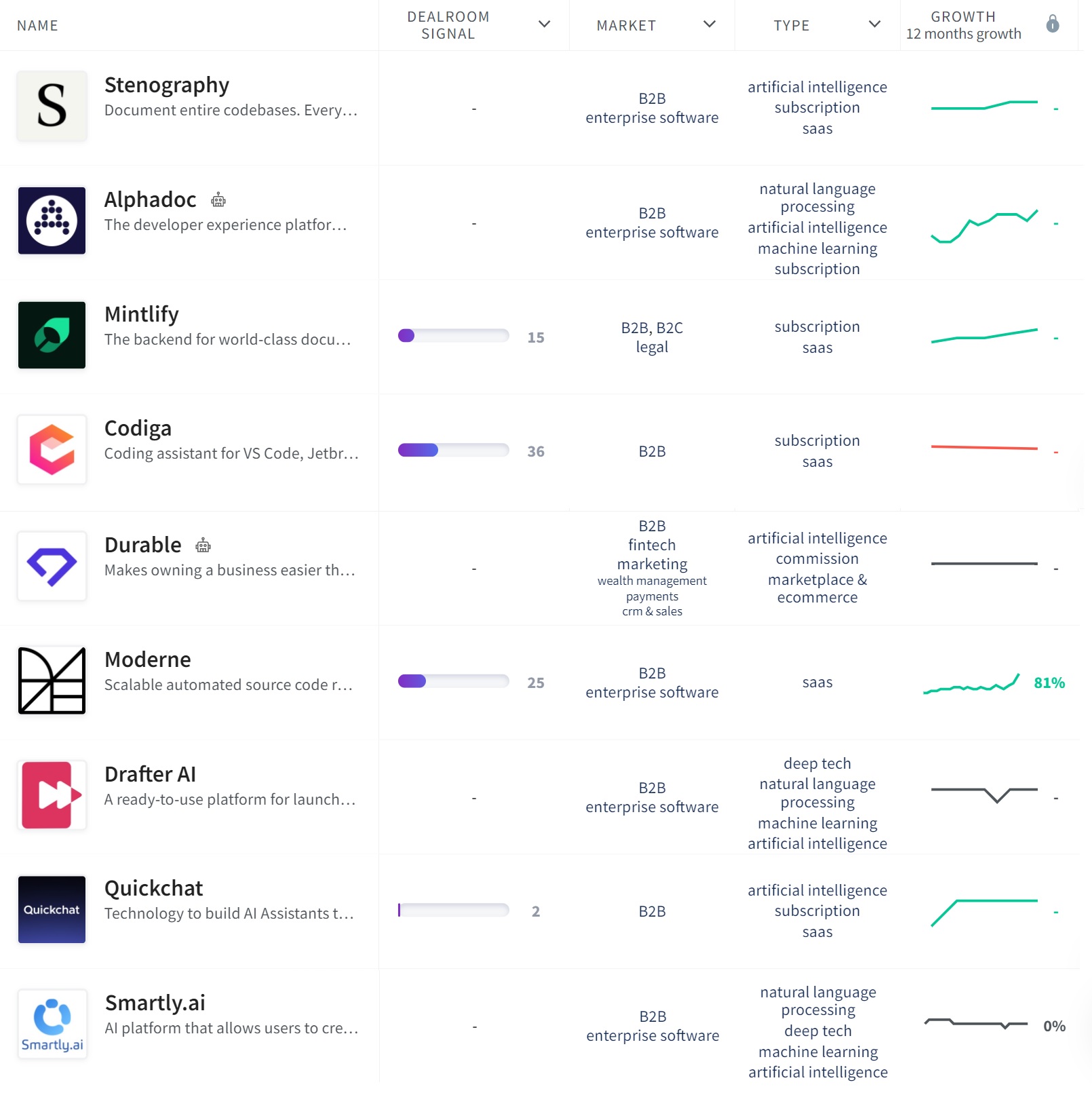
1. Alphadoc 2.Codiga 3. Moderne 4.Smartly.ai 5.Mintlify 6.Drafter AI 7. QuickChat 8. Stenography and 9. Codiga.
Category – Video

1. Elai 2.Wombo.ai 3. Munch 4. Synthesia 5.Colossyan 6.Rephrase.ai 7.RunwayML 8. Phenaki 9. Fliki 10.Tavus 11.Youai and 12. Hour One AI
Category – Audio (Music Generation)

1. Krotos 2. Beatoven.ai 3. AiMi 4. Aiva Technologies 5. Endel 6.Loudly 7.Soundful 8. Musico 9. Mubert 10. Soundraw and 11.Boomy.
Category – Image Generation
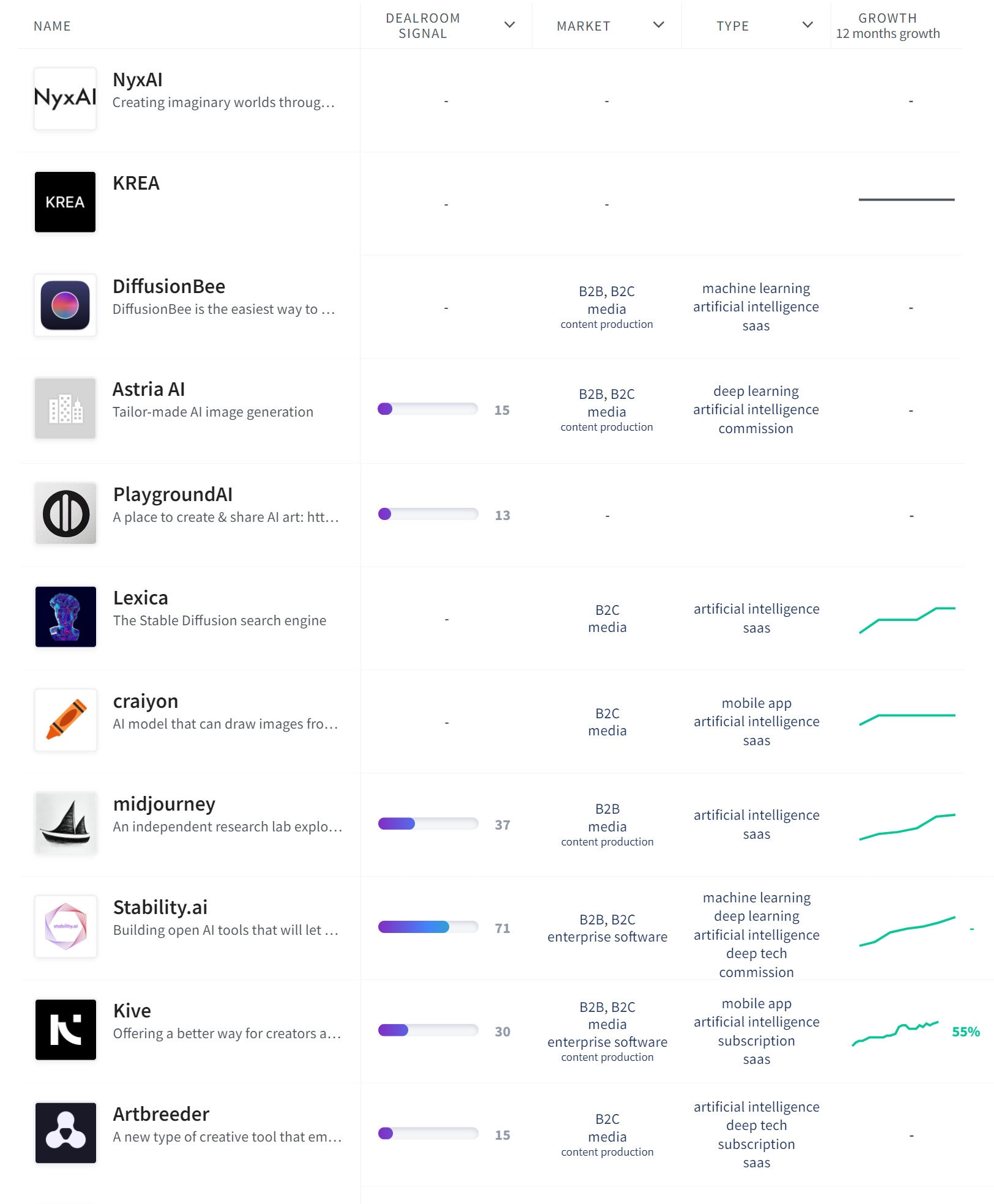
1. Artbreeder 2. Astria AI 3. PlaygroundAI 4.DiffusionBee 5.Kive 6.Stability.ai 7.Rosebud AI 8. Midjourney 9. CraIyon and 10. KREA.
Category – General Intelligence
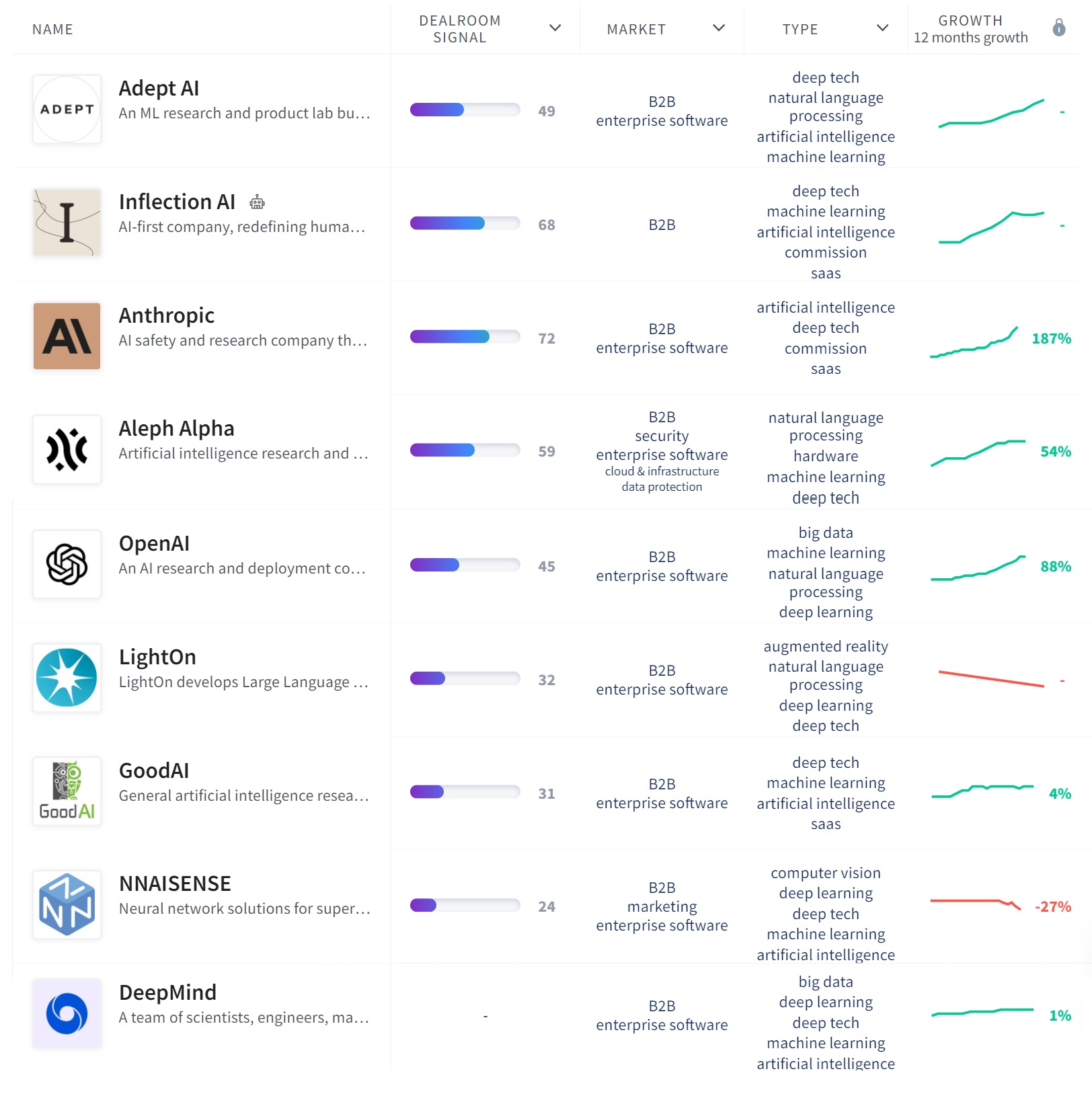
1. Adept AI 2.DeepMind 3. LightOn 4. Anthropic 5.OpenAI 6. Aleph Alpha 7. Inflection AI 8. GoodAI 9. NNAISENSE and 10. Aleph Alpha
Category – Speech Generation
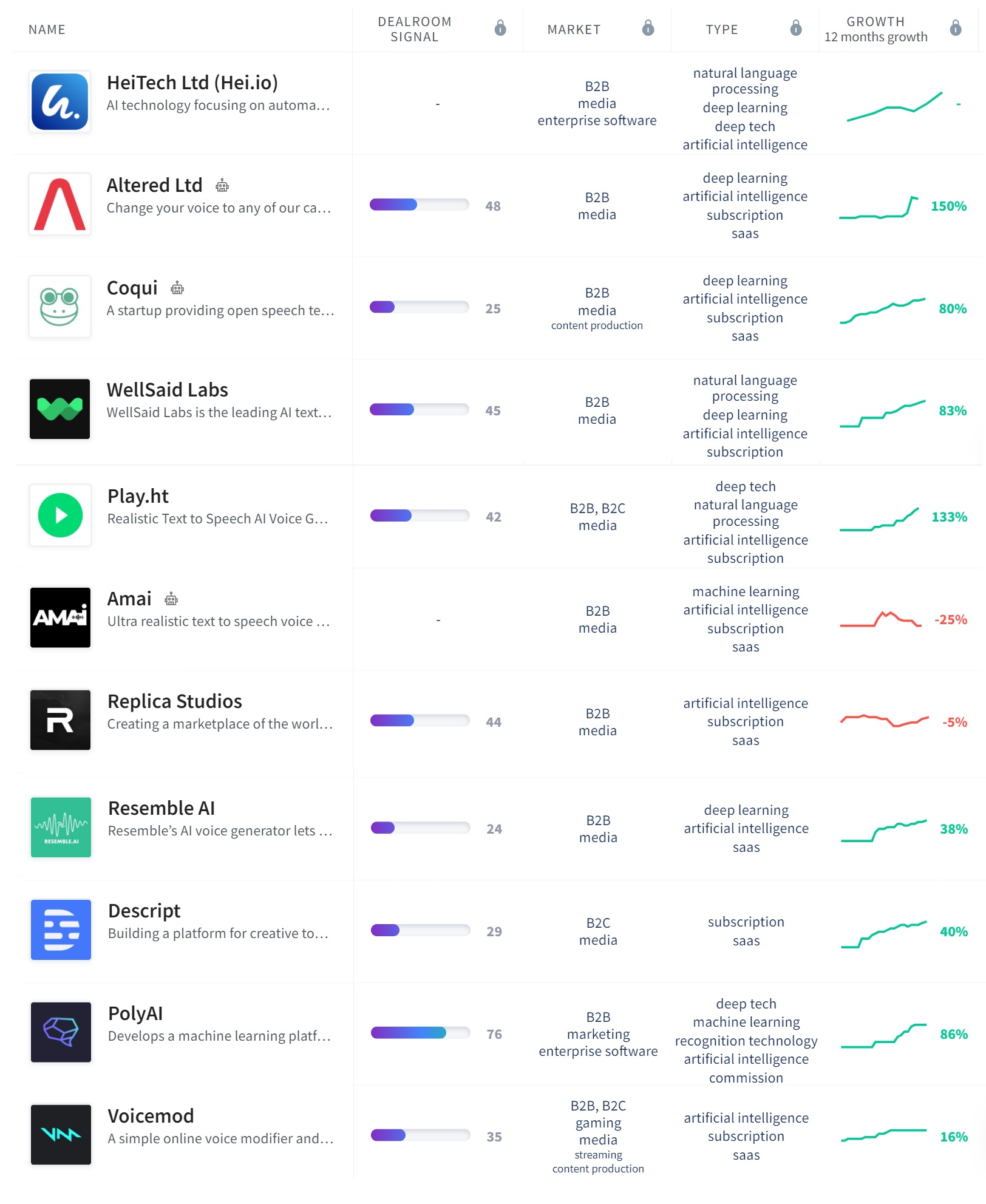
1. Altered Ltd 2. Amai 3.Descript 4. Replica Studios 5. Play.ht 6. Resemble AI 7. WellSaid Labs 8. HeiTech Ltd 9. Coqui and 10. Voicemod.
Category – Design and Marketing
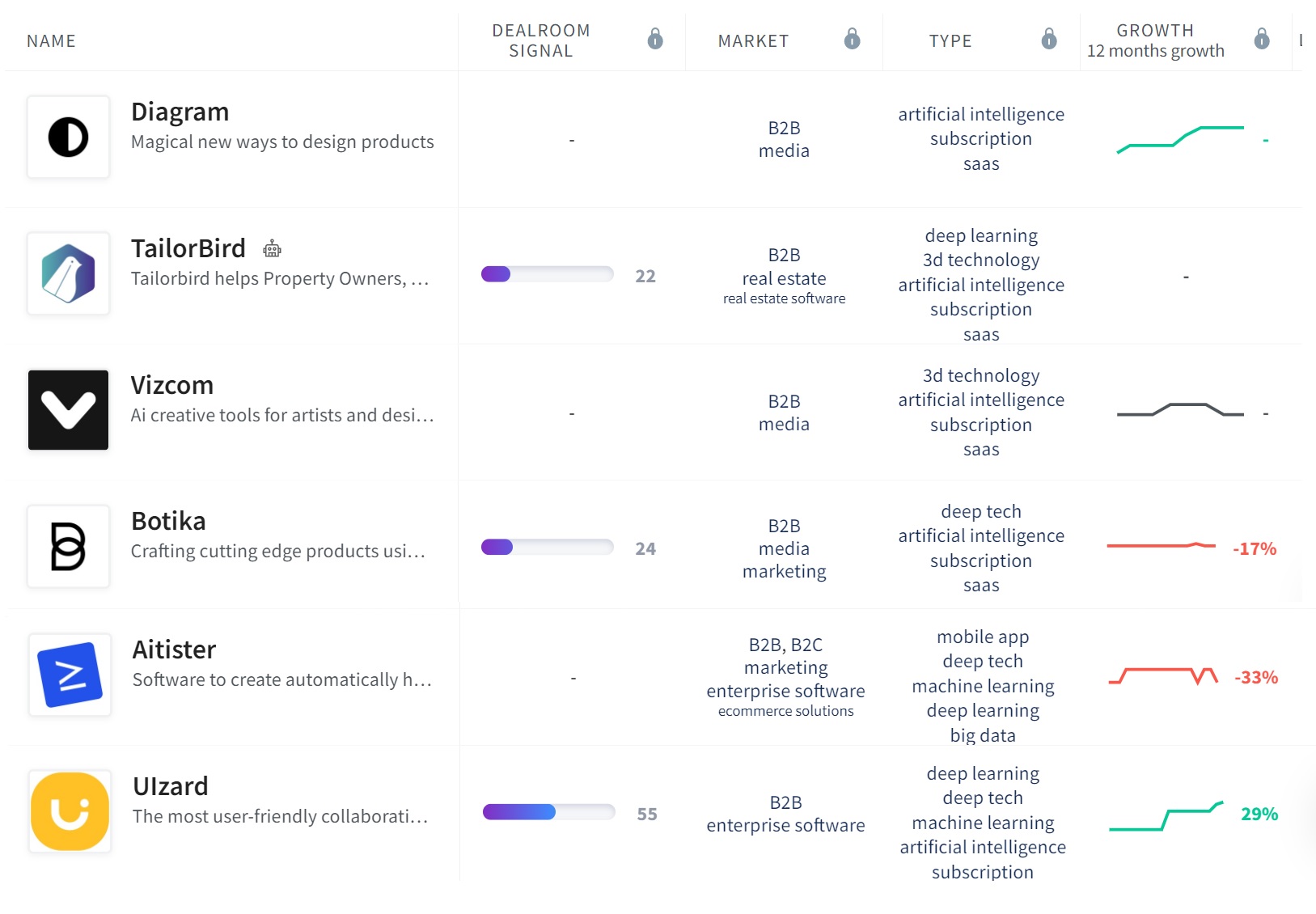
1. TailorBird 2. Aitister 3. Botika 4. Diagram 5. Vizcom and 6. Ulzard.
Category – Code Generation

1. Enzyme 2. The Dotcom 3. Yurts AI 4. AI2SQL 5. Debuild 6. MutableAI 7. Warp 8. Diffblue 9. Machinet 10. Repl.it 11. GitHub 12. TabNine and 13. Pygma.
Generative AI Statistics By Interest
- On a scale of 100 index points, the generative AI popularity can be seen in the increasing stage as we entered the year 2023.
- Before September 2022, the popularity index score was merely seen jumping from 2 to 8 while it crossed 20 in October 2022.
- Since then, the generative AI popularity score hasn’t reduced to below level 20.
- As of 12th February 2023, the popularity score of generative AI reached 100 and it stagnant since then.
Conclusion
These eye catchy Generative AI Statistics are telling us that the world is changing, and technology is advancing. When Elon Musk said, we need to take advantages of the technology and need to make it more advance otherwise it will go out of circle has really becoming a true word. Furthermore, Gartner’s predictions are also going to become true if the technology is going to replace human. But no matter what people say, it is humans only who have created the technology and led it to the digitalized world.
Sources
FAQ.
By the year 2030, the projected growth rate of the Global Generative AI Market is 34.6% reaching $109,370 million.
Companies such as Amazon Web Services, IBM, Microsoft, Google LLC, Adobe, Genie AI Ltd, Synthesia, D-ID, and Mostly AI Ince are some of the top players in the global generative AI Market.
Generative AI possess threats to data privacy concerns, ethical issues, control problems, security issues, and pseudo-image generation. These are only identified problems and every day researchers are coming to know about new issues of such technology.
Minecraft is one of the best AI-based games ever.

Barry is a lover of everything technology. Figuring out how the software works and creating content to shed more light on the value it offers users is his favorite pastime. When not evaluating apps or programs, he's busy trying out new healthy recipes, doing yoga, meditating, or taking nature walks with his little one.